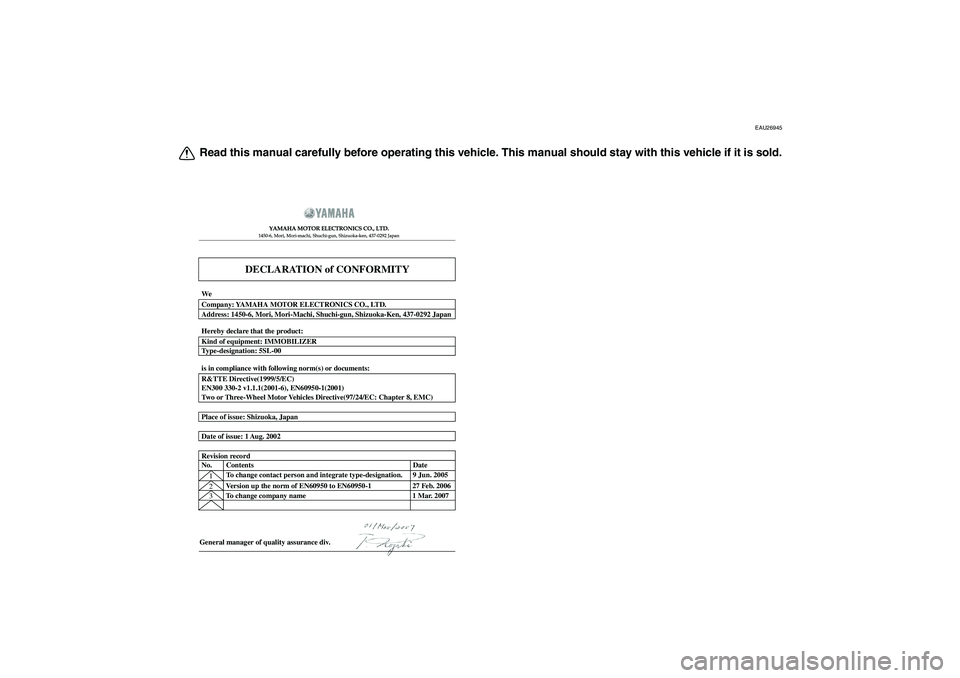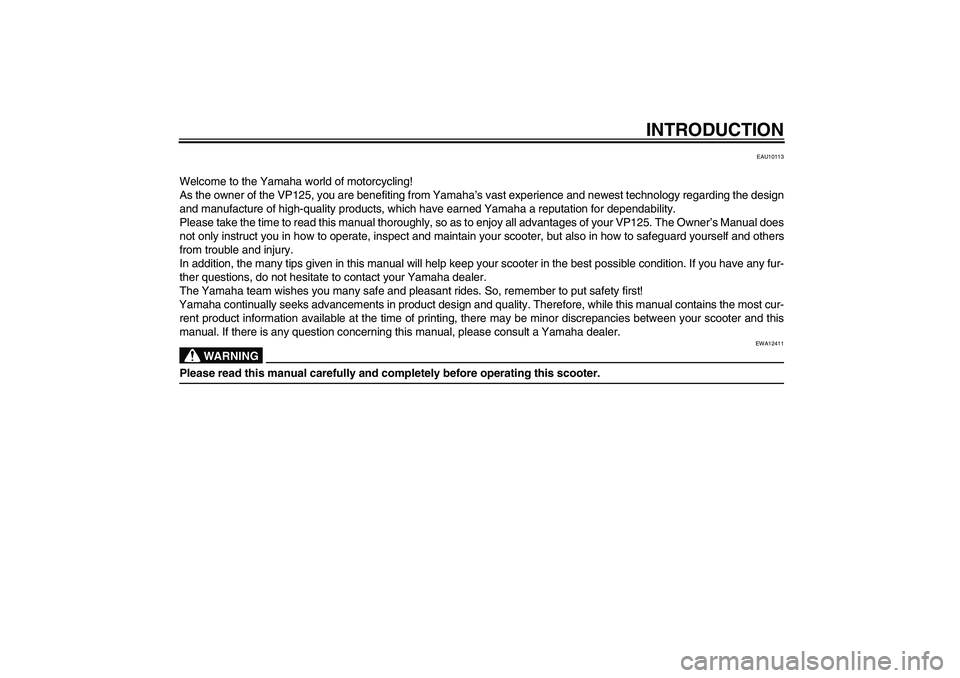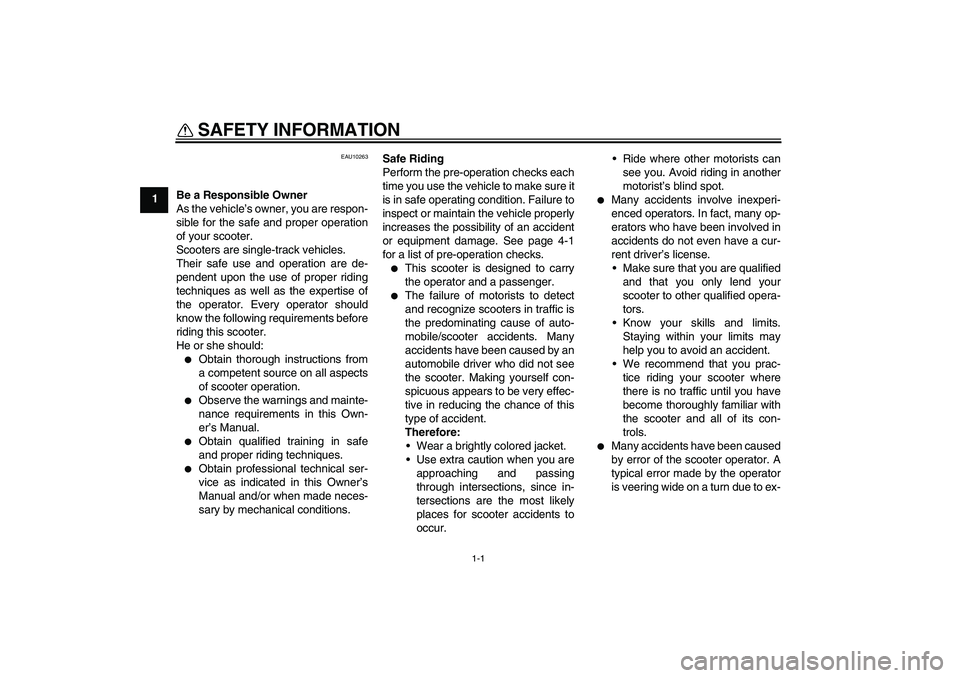Page 1 of 82
PANTONE285CVC
VP125
OWNER’S MANUAL
16P-F8199-E1
Read this manual carefully before operating this vehicle.
Page 2 of 82

EAU26945
Read this manual carefully before operating this vehicle. This manual should stay with this vehicle if it is sold.
DECLARATION of CONFORMITY
YAMAHA MOTOR ELECTRONICS CO., LTD.1450-6, Mori, Mori-machi, Shuchi-gun, Shizuoka-ken, 437-0292 Japan
General manager of quality assurance div.1
Version up the norm of EN60950 to EN60950-1
To change company name27 Feb. 2006
1 Mar. 2007
2
3Revision record
No. Contents Date
To change contact person and integrate type-designation. 9 Jun. 2005Date of issue: 1 Aug. 2002Place of issue: Shizuoka, JapanR&TTE Directive(1999/5/EC)
EN300 330-2 v1.1.1(2001-6), EN60950-1(2001)
Two or Three-Wheel Motor Vehicles Directive(97/24/EC: Chapter 8, EMC) is in compliance with following norm(s) or documents:Kind of equipment: IMMOBILIZER
Type-designation: 5SL-00 Hereby declare that the product:Company: YAMAHA MOTOR ELECTRONICS CO., LTD.
Address: 1450-6, Mori, Mori-Machi, Shuchi-gun, Shizuoka-Ken, 437-0292 JapanWe
U16PE1E0.book Page 1 Monday, July 28, 2008 9:57 AM
Page 3 of 82

INTRODUCTION
EAU10113
Welcome to the Yamaha world of motorcycling!
As the owner of the VP125, you are benefiting from Yamaha’s vast experience and newest technology regarding the design
and manufacture of high-quality products, which have earned Yamaha a reputation for dependability.
Please take the time to read this manual thoroughly, so as to enjoy all advantages of your VP125. The Owner’s Manual does
not only instruct you in how to operate, inspect and maintain your scooter, but also in how to safeguard yourself and others
from trouble and injury.
In addition, the many tips given in this manual will help keep your scooter in the best possible condition. If you have any fur-
ther questions, do not hesitate to contact your Yamaha dealer.
The Yamaha team wishes you many safe and pleasant rides. So, remember to put safety first!
Yamaha continually seeks advancements in product design and quality. Therefore, while this manual contains the most cur-
rent product information available at the time of printing, there may be minor discrepancies between your scooter and this
manual. If there is any question concerning this manual, please consult a Yamaha dealer.
WARNING
EWA12411
Please read this manual carefully and completely before operating this scooter.
U16PE1E0.book Page 1 Monday, July 28, 2008 9:57 AM
Page 4 of 82
IMPORTANT MANUAL INFORMATION
EAU10132
Particularly important information is distinguished in this manual by the following notations:
This is the safety alert symbol. It is used to alert you to potential personal injury
hazards. Obey all safety messages that follow this symbol to avoid possible injury
or death.
A WARNING indicates a hazardous situation which, if not avoided, could result in
death or serious injury.
A NOTICE indicates special precautions that must be taken to avoid damage to the
vehicle or other property.
A TIP provides key information to make procedures easier or clearer.
WARNING
NOTICETIP
U16PE1E0.book Page 1 Monday, July 28, 2008 9:57 AM
Page 5 of 82
IMPORTANT MANUAL INFORMATION
EAUM1010
VP125
OWN ER’S MANUAL
©2008 by MBK INDUSTRIE
1st edition, July 2008
All rights reserved
Any reprinting or unauthorized use
without the written permission of
MBK INDUSTRIE
is expressly prohibited.
Printed in France.
U16PE1E0.book Page 2 Monday, July 28, 2008 9:57 AM
Page 6 of 82

TABLE OF CONTENTSSAFETY INFORMATION ..................1-1
Further safe-riding points ................1-5
DESCRIPTION ..................................2-1
Left view ..........................................2-1
Right view ........................................2-2
Controls and instruments.................2-3
INSTRUMENT AND CONTROL
FUNCTIONS.......................................3-1
Immobilizer system .........................3-1
Main switch/steering lock ................3-2
Indicator and warning lights ............3-3
Speedometer ..................................3-4
Fuel gauge ......................................3-5
Coolant temperature gauge ............3-5
Multi-function display ......................3-5
Handlebar switches ........................3-8
Front brake lever ............................3-9
Rear brake lever .............................3-9
Fuel tank cap ................................3-10
Fuel ...............................................3-10
Catalytic converters ......................3-12
Seat ..............................................3-12
Storage compartments .................3-13
Windshield ....................................3-14
Adjusting the shock absorber
assemblies ................................3-15
Carrier ...........................................3-16
Luggage hook ...............................3-16
Sidestand ......................................3-16Ignition circuit cut-off system ........ 3-17
FOR YOUR SAFETY –
PRE-OPERATION CHECKS............. 4-1
OPERATION AND IMPORTANT
RIDING POINTS................................. 5-1
Starting the engine ......................... 5-1
Starting off ...................................... 5-2
Acceleration and deceleration ........ 5-2
Braking ........................................... 5-3
Tips for reducing fuel
consumption ............................... 5-3
Engine break-in .............................. 5-4
Parking ........................................... 5-4
PERIODIC MAINTENANCE AND
ADJUSTMENT................................... 6-1
Owner’s tool kit ............................... 6-1
Periodic maintenance and
lubrication chart .......................... 6-2
Removing and installing cowlings
and panels .................................. 6-6
Checking the spark plug ................. 6-7
Engine oil ....................................... 6-8
Final transmission oil .................... 6-11
Coolant ......................................... 6-12
Air filter and V-belt case air filter
elements ................................... 6-13
Checking the throttle cable free
play ........................................... 6-14Valve clearance ........................... 6-15
Tires ............................................. 6-15
Cast wheels ................................. 6-17
Front and rear brake lever free
play ........................................... 6-17
Checking the front and rear brake
pads .......................................... 6-18
Checking the brake fluid level ...... 6-18
Changing the brake fluid .............. 6-19
Checking and lubricating the
cables ....................................... 6-20
Checking and lubricating the
throttle grip and cable ............... 6-20
Lubricating the front and rear
brake levers .............................. 6-20
Checking and lubricating the
centerstand and sidestand ....... 6-21
Checking the front fork ................. 6-21
Checking the steering .................. 6-22
Checking the wheel bearings ....... 6-22
Battery ......................................... 6-23
Replacing the fuses ..................... 6-24
Replacing a headlight bulb .......... 6-25
Replacing a front turn signal light
bulb ........................................... 6-27
Replacing a tail/brake light bulb or
a rear turn signal light bulb ....... 6-27
Replacing the license plate light
bulb ........................................... 6-28
Replacing an auxiliary light
bulb ........................................... 6-28U16PE1E0.book Page 1 Monday, July 28, 2008 9:57 AM
Page 7 of 82
TABLE OF CONTENTS
Troubleshooting ............................ 6-29
Troubleshooting charts ................. 6-30
SCOOTER CARE AND STORAGE... 7-1
Care ................................................ 7-1
Storage ...........................................7-3
SPECIFICATIONS ............................. 8-1
CONSUMER INFORMATION............. 9-1
Identification numbers .................... 9-1
U16PE1E0.book Page 2 Monday, July 28, 2008 9:57 AM
Page 8 of 82

1-1
1
SAFETY INFORMATION
EAU10263
Be a Responsible Owner
As the vehicle’s owner, you are respon-
sible for the safe and proper operation
of your scooter.
Scooters are single-track vehicles.
Their safe use and operation are de-
pendent upon the use of proper riding
techniques as well as the expertise of
the operator. Every operator should
know the following requirements before
riding this scooter.
He or she should:�
Obtain thorough instructions from
a competent source on all aspects
of scooter operation.
�
Observe the warnings and mainte-
nance requirements in this Own-
er’s Manual.
�
Obtain qualified training in safe
and proper riding techniques.
�
Obtain professional technical ser-
vice as indicated in this Owner’s
Manual and/or when made neces-
sary by mechanical conditions.Safe Riding
Perform the pre-operation checks each
time you use the vehicle to make sure it
is in safe operating condition. Failure to
inspect or maintain the vehicle properly
increases the possibility of an accident
or equipment damage. See page 4-1
for a list of pre-operation checks.
�
This scooter is designed to carry
the operator and a passenger.
�
The failure of motorists to detect
and recognize scooters in traffic is
the predominating cause of auto-
mobile/scooter accidents. Many
accidents have been caused by an
automobile driver who did not see
the scooter. Making yourself con-
spicuous appears to be very effec-
tive in reducing the chance of this
type of accident.
Therefore:
Wear a brightly colored jacket.
Use extra caution when you are
approaching and passing
through intersections, since in-
tersections are the most likely
places for scooter accidents to
occur.Ride where other motorists can
see you. Avoid riding in another
motorist’s blind spot.
�
Many accidents involve inexperi-
enced operators. In fact, many op-
erators who have been involved in
accidents do not even have a cur-
rent driver’s license.
Make sure that you are qualified
and that you only lend your
scooter to other qualified opera-
tors.
Know your skills and limits.
Staying within your limits may
help you to avoid an accident.
We recommend that you prac-
tice riding your scooter where
there is no traffic until you have
become thoroughly familiar with
the scooter and all of its con-
trols.
�
Many accidents have been caused
by error of the scooter operator. A
typical error made by the operator
is veering wide on a turn due to ex-
U16PE1E0.book Page 1 Monday, July 28, 2008 9:57 AM